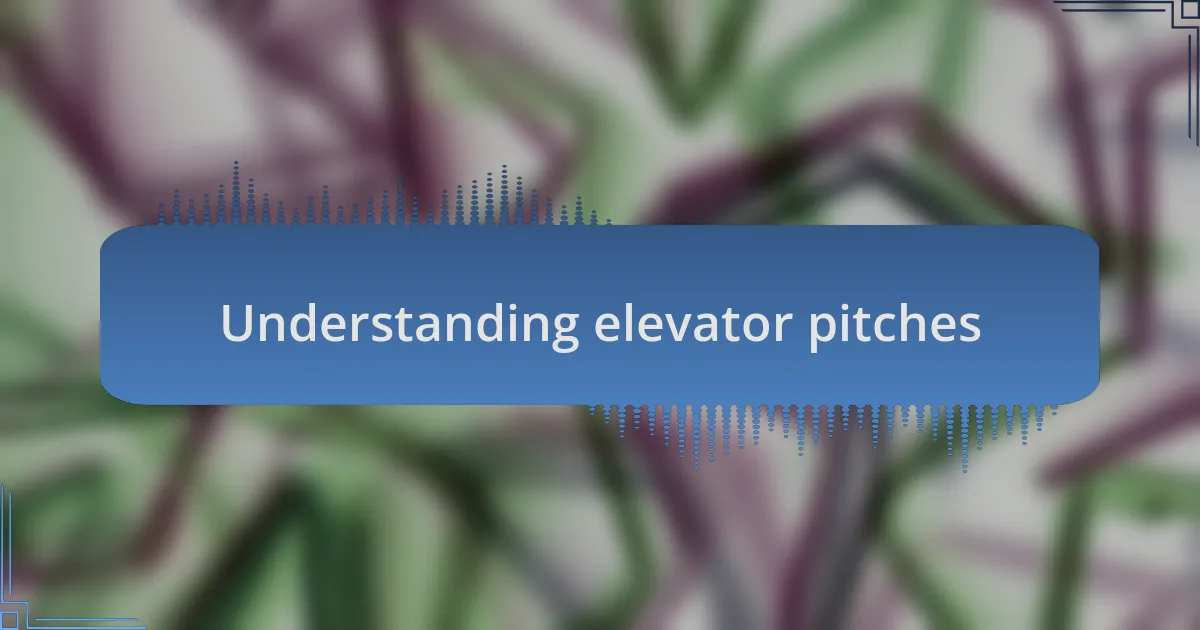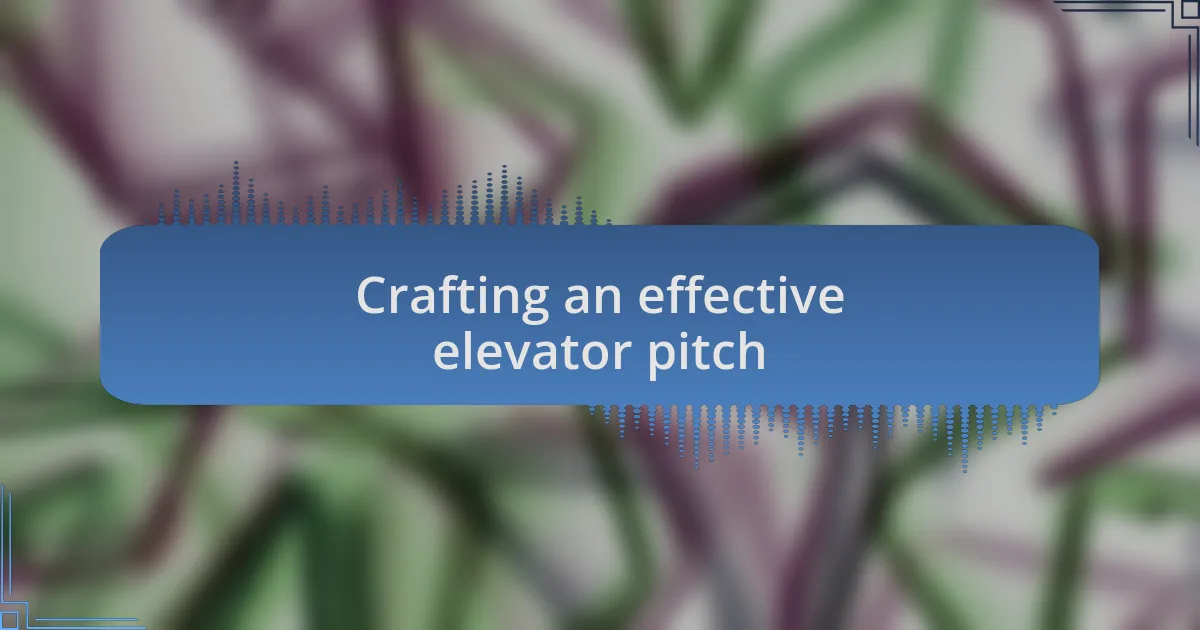Key takeaways:
- An effective elevator pitch should be concise, engaging, and aligned with the audience’s interests to create a lasting impression.
- Storytelling and personal experiences can transform a pitch from purely transactional to emotionally engaging.
- Practicing delivery through reflection, recording, and seeking feedback is essential for clarity and confidence in presenting your pitch.
- Creating a sense of urgency or importance can intrigue the listener and spark further conversation.

Understanding elevator pitches
Elevator pitches are concise, persuasive messages that communicate who you are, what you do, and why it matters—all within the time it takes to ride an elevator, typically about 30 seconds to two minutes. I remember crafting my first pitch; I was nervous and rehearsed until it felt like second nature. The thrill of encapsulating a concept so succinctly taught me not only the value of brevity but also the importance of passion in delivery.
When I think about effective elevator pitches, I often reflect on the impact of storytelling. For instance, I once shared a story about a challenge I faced that led to my business idea, which drew my listener’s attention immediately. Have you ever felt compelled to listen to someone because they wove their personal experience into their pitch? That connection can turn a simple introduction into a memorable exchange.
Ultimately, understanding the essence of an elevator pitch lies in recognizing its purpose: to intrigue and engage the listener, sparking curiosity. I have found that if I can create a sense of urgency or importance in my pitch, the listener is more likely to remember. So, consider this—what question would you want to leave them with at the end of your pitch to keep them wanting more?

Importance of elevator pitches
Elevator pitches play a crucial role in establishing the first impression, often determining whether a conversation continues or fizzles out. I recall attending a networking event where my pitch helped me connect with a potential investor in just a few moments. The ability to convey my passion and vision quickly proved to be a game-changer, reaffirming that each word counts in making that initial connection.
The importance of a well-crafted elevator pitch goes beyond mere introductions. It’s an opportunity to express your unique value and resonate with an audience that may be hearing your idea for the first time. I remember a moment when a simple sentence sparked genuine interest from someone who later became a valued mentor. Isn’t it fascinating how a few well-chosen words can create opportunities?
Additionally, a strong elevator pitch can differentiate you in a crowded marketplace. I learned this firsthand when I retooled my pitch based on feedback, leading to clearer communication of my brand identity. Have you ever felt that delightful click of understanding? That’s the golden moment your pitch should aim for—not just to inform, but to ignite curiosity and dialogue.

Crafting an effective elevator pitch
Crafting an effective elevator pitch requires brevity and clarity. I remember my first attempt at a pitch, which was packed with technical jargon. It was a disaster! When I simplified my message to focus on the core of my idea, I noticed that it not only became easier for others to understand, but people actually leaned in, eager to hear more. Can you imagine the difference a few simple words can make in building that connection?
As I fine-tuned my pitch, I realized the importance of storytelling. Instead of listing facts, I began to weave in a personal experience that illustrated my vision. One time, sharing my journey of overcoming a challenge in my business resonated deeply with my audience. They responded not just with nods, but with genuine interest. Isn’t it amazing how vulnerability can transform a pitch from merely transactional to truly engaging?
Lastly, practicing your pitch is essential. I’ve stood in front of mirrors, refining my delivery until it felt natural. Each rehearsal revealed nuances in tone and pacing that drew people in, turning my pitch into a conversation rather than a monologue. Have you practiced your pitch lately? It’s in those repetitions that the magic happens, making your message not just heard, but felt.

Personalizing your elevator pitch
To truly personalize your elevator pitch, I’ve found that aligning it with your audience’s interests is critical. When I was pitching at a local startup event, I tailored my message based on the attendees’ backgrounds. By referencing their common challenges, I noticed heads nodding in agreement. Have you thought about what shared experiences you can highlight to create an instant connection?
Another technique I’ve employed is incorporating a touch of humor or a light-hearted story. During one pitch, I casually mentioned a funny incident that unfolded while launching my first product. The audience laughed, breaking the ice, and suddenly my pitch felt less formal. Can you recall a moment that might make people smile or relate? Adding that personal flair can make your pitch memorable.
I also believe that showing passion in your voice and body language contributes significantly to personalization. When I genuinely express my enthusiasm, it’s almost contagious. I once pitched an idea about a project I deeply cared about and watched as the energy shifted. Have you ever noticed how passion draws people in? It’s that emotional connection that can turn a good pitch into a great one.

Tips for practicing your pitch
Practicing your pitch is essential to delivering it confidently. When I first started, I would practice in front of a mirror, paying close attention to my facial expressions and posture. This simple step made me more aware of how I presented not just my words, but also my demeanor. Have you ever considered how visual feedback can enhance your delivery?
Another technique that I’ve found incredibly helpful is recording myself during practice runs. Listening to the playback allows me to pinpoint areas for improvement. I remember cringing at how quickly I spoke in one recording, realizing it made it hard to follow my message. What about you? Have you listened to your pitch, and if so, what surprised you about your delivery?
Finally, I encourage you to practice with friends or mentors who can provide constructive feedback. I once rehearsed with a colleague who pointed out some jargon I was using that could confuse my audience. This experience reminded me that clarity is key. How often do you seek feedback, and how has that influenced your pitch development? It’s those insights that can make all the difference.

Real-life examples of successful pitches
One standout example of a successful elevator pitch comes from a friend who launched a sustainable bakery. In just 30 seconds, she captivated her audience by linking her passion for baking with her commitment to the environment. She said, “Imagine a cookie that not only delights your taste buds but also nurtures the planet.” Hearing this always makes me think—how can I make my own pitch resonate emotionally with my audience?
Another impressive pitch I encountered was during a local startup event. A young entrepreneur succinctly outlined her app’s unique features by presenting a relatable scenario: “Picture your morning commute—now imagine it hassle-free.” The energy in the room shifted instantly as everyone could visualize the benefit of her idea. It struck me as vital; storytelling can be an incredibly persuasive tool in pitching.
Lastly, I’ve observed how a former colleague turned a chance meeting into a partnership through his pitch about a tech solution. He presented his idea not just as a product, but as a solution to a common problem that many faced. His direct approach of asking, “How many times have you struggled with this?” engaged listeners and made them reflect on their own experiences. I often wonder, what questions can I ask in my pitch to draw my audience in?